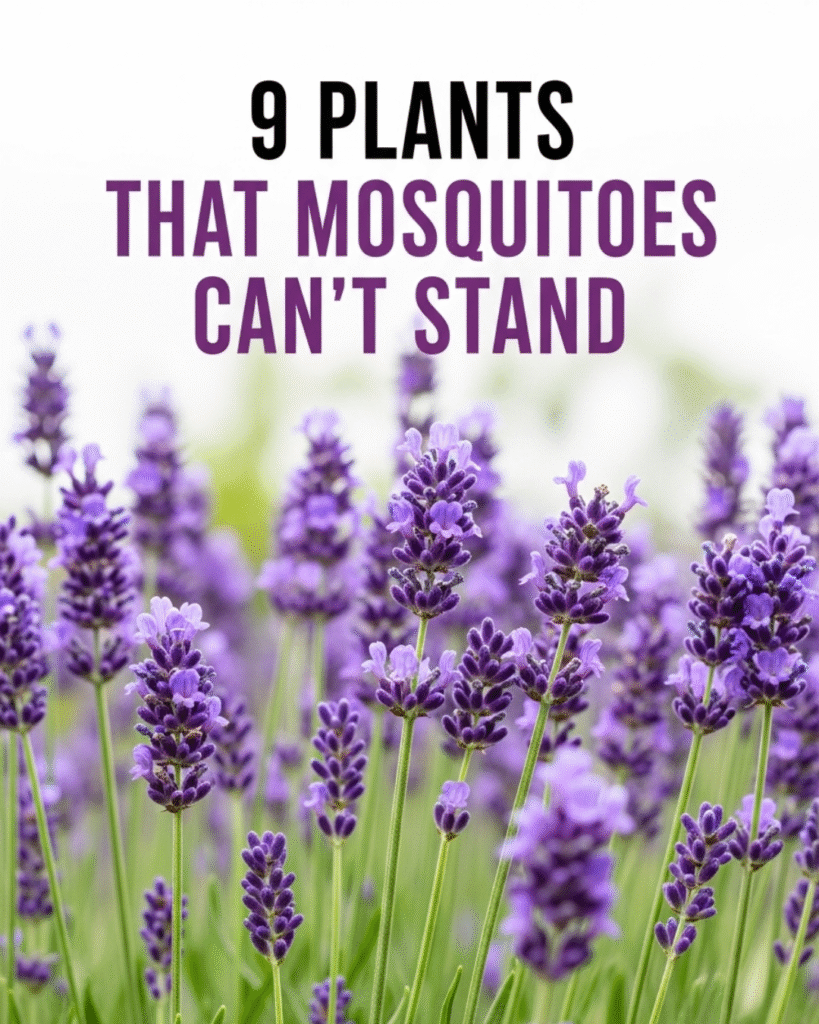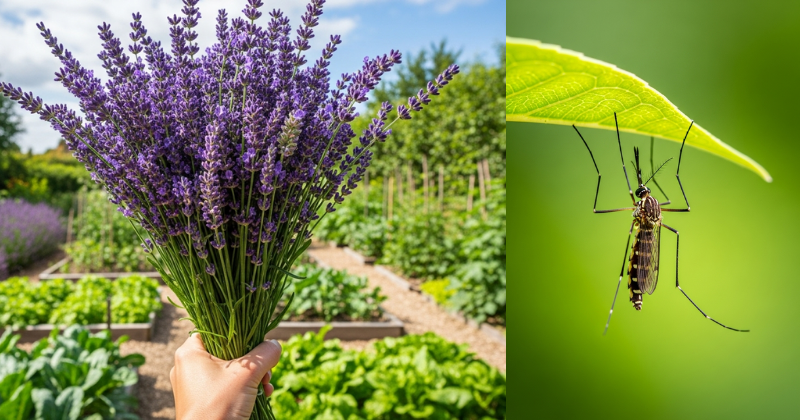Are biting mosquitoes turning your beautiful outdoor space into an itchy nightmare? You don’t have to rely on harsh chemical sprays to reclaim your patio. By strategically planting the 9 PLANTS THAT MOSQUITOES CAN NOT STAND, you can create a natural, fragrant barrier that repels pests while attracting beneficial insects. This guide will empower you to discover the power of botanical pest control, helping you transform your yard into a peaceful sanctuary. Get ready to embrace the connection with nature and ecosystem benefits, achieving a summer free from unwanted buzzing!

🌿 Foundation First: How Plants Naturally Repel Mosquitoes
The secret behind the 9 PLANTS THAT MOSQUITOES CAN NOT STAND lies in their essential oils. These oils, developed by the plants as a natural defense mechanism against herbivores, contain powerful compounds that interfere with a mosquito’s ability to detect human $\text{CO}_2$ and body odor.
Mosquitoes are drawn to us by the scent of carbon dioxide, lactic acid, and other organic compounds we emit. Repellent plants work by masking these attractive scents with overwhelming, unpleasant fragrances.
| Plant Compound | Primary Repellent Function | Examples |
| Citronellal | Overpowers scent receptors. | Citronella, Lemon Balm |
| Linalool | Causes disorientation in insects. | Lavender, Basil |
| Coumarin | Has anticoagulant properties (natural pesticide). | Sweet Woodruff (use with caution) |
This understanding reinforces the connection with nature and gives you the achievable, step-by-step guidance needed to choose your arsenal wisely.
H3: Addressing Common Concerns: Activation is Key
A common concern is: “Why are the mosquitoes still biting, even though I have a few potted plants?”
- The Reality: The mere presence of these plants is often not enough. To release the high concentration of repellent oils, the leaves must be crushed, brushed, or rubbed.
- Encouraging Reassurance: Strategic placement and activation (gently crushing a few leaves before heading outside) are the keys to unlocking the full potential of these botanical repellents.
🪴 Section 2: The 9 Plants That Mosquitoes Cannot Stand
Here are the powerhouse plants you need to integrate into your garden for a natural, buzz-free zone.
1. Citronella Geranium (Pelargonium citrosum)
While often mistaken for true Citronella grass, this popular ornamental contains citronellal, which is highly effective.
- Best Use: Plant in large containers on the patio or near entryways. Ensure its placement is in full sun.
- Pro Tip: Gently brush the leaves as you pass by to release the oils into the air.
2. Lavender (Lavandula)
A beautiful, fragrant addition that offers a significant $\text{ecosystem benefit}$ by attracting pollinators while simultaneously deterring mosquitoes and certain moths.
- Best Use: Plant near sitting areas and walkways. The high concentration of linalool is offensive to mosquitoes.
- Regional Variations: English Lavender is best for cooler climates; French and Spanish varieties prefer heat.
3. Basil (Ocimum basilicum)
This common culinary herb contains four volatile oils, including linalool and estragole, making it an excellent mosquito repellent.
- Best Use: Grow in pots directly on your outdoor dining table. The act of tearing a basil leaf for a meal releases fresh repellent compounds.
4. Lemon Balm (Melissa officinalis)
A vigorous, easy-to-grow herb from the mint family, containing high levels of citronellal.
- Best Use: Plant in dedicated containers, as it can be highly invasive if placed directly in garden beds. Rub the leaves onto skin for a temporary, all-natural skin repellent.
5. Catnip (Nepeta cataria)
Catnip is a scientifically proven powerhouse. The compound nepetalactone has been shown in studies to be 10 times more effective at repelling mosquitoes than $\text{DEET}$.
- Best Use: Plant near seating areas. Be aware: it’s a huge attractant for cats!
6. Peppermint (Mentha piperita)
Another mint family member whose strong, pungent aroma is repulsive to mosquitoes.
- Best Use: Crush the leaves and rub them on outdoor furniture. Peppermint oil, diluted with a carrier oil, can be used as a topical repellent.
7. Rosemary (Salvia rosmarinus)
Rosemary’s woody, piney scent is highly effective at repelling insects, including mosquitoes, cabbage moths, and flies.
- Best Use: Grow in containers near the grill. Tossing sprigs onto hot coals or directly into a fire pit releases the essential oils into the smoke, amplifying the repellent effect.
8. Marigolds (Tagetes)
These cheerful annuals contain pyrethrum, a compound used in many commercial insect repellents.
- Best Use: Plant in vegetable gardens to protect crops, and line them along patio edges and windowsills to deter mosquitoes from entering your home.
9. Garlic (Allium sativum)
While not typically placed in ornamental areas, the sulfur compounds released by garlic are highly effective mosquito deterrents.
- Best Use: Plant small clusters of garlic strategically around your yard’s perimeter or near stagnant water sources.
🌻 Section 3: Step-by-Step Process for Optimal Placement
Knowing the 9 PLANTS THAT MOSQUITOES CAN NOT STAND is only part of the solution; placement is paramount to creating a protective barrier.
Core Methods: Strategic Zoning
- Define Your Perimeter: Identify the outdoor spaces where you spend the most time (patio, deck, swing set). This is your high-priority defense zone.
- The “Perimeter and Patrol” Strategy: Use larger, densely planted bushes like Lavender and Rosemary to create a primary perimeter barrier (the achievable, step-by-step guidance). Then, use smaller, more volatile plants (Basil, Lemon Balm, Peppermint) in portable pots directly on tables and near chairs. These are your “Patrol” plants, designed for easy activation.
- Encourage Activation: Place Lemon Balm and Catnip where you will naturally brush against them (near the path or stair edge). The physical contact releases the necessary oils, making activation a seamless part of your daily routine.
🌡️ Section 4: Advanced Strategies and Troubleshooting
To maximize the benefits of the 9 PLANTS THAT MOSQUITOES CAN NOT STAND, you must consider environmental factors and advanced application techniques.
Featured Snippet Potential: “Do mosquito-repelling plants work if I don’t crush the leaves?”
No, most mosquito-repelling plants do not work effectively unless their leaves are crushed or gently rubbed. The repellent compounds are stored in the essential oils within the leaf tissue. Simply having the plant nearby releases only a faint scent. To unlock the full repellent power, you must manually release these oils by crushing or brushing the leaves.
Practical Troubleshooting Tips (Gardening Focus)
- Problem: Plants are wilting and looking sparse (less potent oils).
- Likely Cause: Insufficient sun. Most of these aromatic herbs require 6-8 hours of direct sun to produce the high concentration of volatile oils needed for strong repellency.
- Solution: Immediately move the potted plants to the sunniest location. For in-ground plants, consider pruning surrounding shade trees or supplementing with sun lamps if growing on a porch.
- Problem: Strong winds are blowing the repellent scent away.
- Likely Cause: Lack of natural windbreaks or strategic grouping.
- Solution: Group your container plants tightly together. The combined mass of fragrance creates a much stronger, more concentrated barrier that is harder for the wind to dissipate. Use large, bushy plants like Citronella Geranium to form the densest barrier.
- Problem: Repellency seems to fade quickly.
- Likely Cause: The volatile oils dissipate rapidly, especially in dry heat.
- Solution: Preventive Measures: Use the Rosemary smoke trick (Tip 7) for supplemental, intense evening coverage. Re-rub leaves every 30-60 minutes during peak mosquito hours (dusk).
🚀 Section 5: Maximizing Results: Next Level Mosquito Defense
Beyond planting and placement, a few next-level tips will ensure you have a truly successful, long-term defense.
- The Herbal Spray Complementary Strategy: Create a powerful, non-toxic topical spray. Steep a handful of Lemon Balm, Peppermint, and Basil leaves in boiling water. Strain, let cool, and mix with equal parts witch hazel or rubbing alcohol. Store in a spray bottle. This is a crucial complementary strategy to enhance the plants’ effectiveness.
- Maintenance and Long-Term Considerations: Many of the 9 PLANTS THAT MOSQUITOES CAN NOT STAND (like Lavender and Rosemary) are perennial, while others (like Marigolds and Basil) are annual. Remember to reseed or replant the annuals every spring and heavily prune the perennials in early spring to encourage dense, bushy growth, which maximizes the leaf surface area and essential oil production.
- Remove Stagnant Water: While planting helps repel, the single most effective way to eliminate mosquitoes is to remove their breeding grounds. Check your yard weekly for standing water in old tires, bird baths, or clogged gutters. This inspires continued growth and learning in managing your local ecosystem.
✅ Conclusion: Your Capability to Reclaim Your Space
You are now fully equipped with the knowledge of the 9 PLANTS THAT MOSQUITOES CAN NOT STAND and the advanced strategies to maximize their power. By implementing strategic placement, regular activation, and proactive maintenance, you empower yourself to transform your outdoor living area into a natural, fragrant, and wonderfully buzz-free zone.
Embrace the joy of your garden and the capability to succeed in creating a safe, pleasant environment.
Which of the 9 PLANTS THAT MOSQUITOES CAN NOT STAND—the highly effective Catnip or the aromatic Rosemary—will be the next addition to your perimeter defense?
